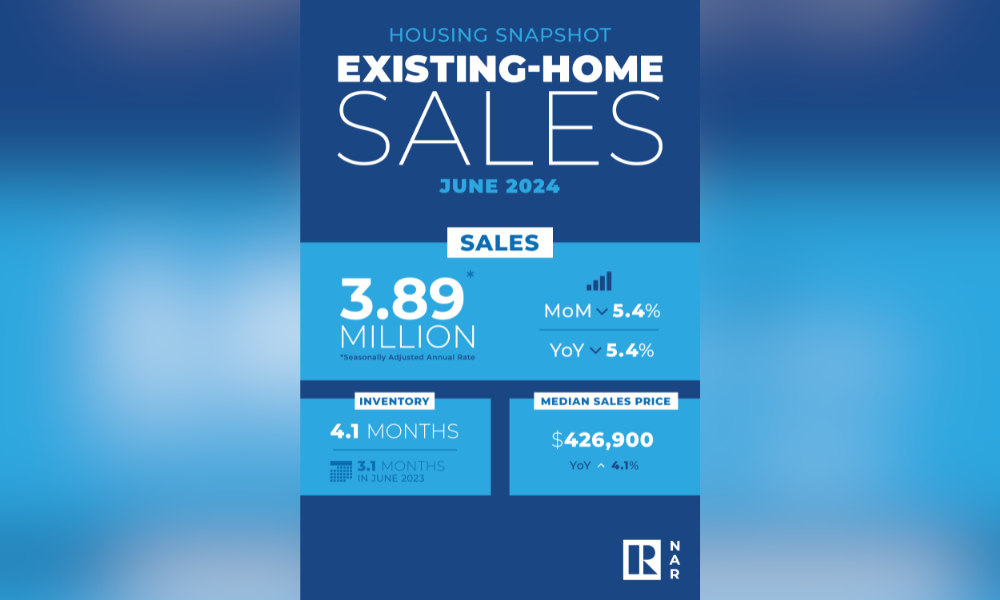"We're seeing slow shift from a seller's market to a buyer's market"

The US housing market is showing signs of a gradual transition from a seller’s market to a buyer’s market, with existing home sales continuing to fall in June, according to the National Association of Realtors (NAR).
Data from NAR revealed a 5.4% drop in existing-home sales in June compared to May, settling at a seasonally adjusted annual rate of 3.89 million. This decline extends to a year-over-year basis as well, with sales falling by 5.4%.
Despite fewer sales, the median existing-home price hit an all-time high of $426,900 – a 4.1% increase from a year ago.
“The housing market displayed a split personality in June,” said Holden Lewis, mortgage expert at NerdWallet. “Fewer people bought existing homes, yet prices jumped to an all-time high. In normal times, those two events wouldn’t happen in the same month, because fewer buyers usually summon lower prices, while rising prices typically are a sign of increased demand from more buyers. But these aren’t typical times.
“Homeowners are only grudgingly listing their homes for sale because they don’t like giving up their low mortgage rates. Not enough homes are on the market to meet demand, and this imbalance of supply and demand is driving up prices.”
NAR chief economist Lawrence Yun said this marks a “slow shift from a seller’s market to a buyer’s market.”
“Homes are sitting on the market a bit longer, and sellers are receiving fewer offers,” he said. “More buyers are insisting on home inspections and appraisals, and inventory is definitively rising on a national basis.”
Properties typically remained on the market for 22 days in June, down from 24 days in May but up from 18 days in June 2023, further indicating a cooling market.
The good news, Lewis added, is that the market is slowly inching toward balance.
The housing inventory at the end of June was 1.32 million units, up 3.1% from May and 23.4% from one year ago. Unsold inventory now sits at a 4.1-month supply at the current sales pace, up from 3.7 months in May and 3.1 months in June 2023. This marks the highest level of unsold inventory since May 2020, when it stood at 4.5 months.
“Each month, buyers have more inventory to choose from, and eventually this dynamic will keep house prices from rising so fast,” Lewis said.
“Even as the median home price reached a new record high, further large accelerations are unlikely,” Yun added. “Supply and demand dynamics are nearing a balanced market condition. The months’ supply of inventory reached its highest level in more than four years.”
Read next: What’s happening to housing availability in Texas?
Selma Hepp, chief economist of CoreLogic, suggested that if the Federal Reserve cuts rates in September, it “could help drive mortgage rates lower and instil some much-needed boost to potential home buyers.”
The report also highlighted differences between single-family homes and condominiums/co-ops. Single-family home sales decreased to a seasonally adjusted annual rate of 3.52 million in June, down 5.1% from May and 4.3% from the prior year. The median existing single-family home price was $432,700 in June, up 4.1% from June 2023.
Meanwhile, existing condominium and co-op sales fell more sharply, tumbling 7.5% in June to a seasonally adjusted annual rate of 370,000 units, down 14% from one year ago. The median existing condo price was $371,700 in June, up 2.6% from the previous year.
First-time buyers were responsible for 29% of sales in June, down from 31% in May but up from 27% in June 2023. All-cash sales accounted for 28% of transactions in June, unchanged from May and up from 26% one year ago.
Stay updated with the freshest mortgage news. Get exclusive interviews, breaking news, and industry events in your inbox, and always be the first to know by subscribing to our FREE daily newsletter.



